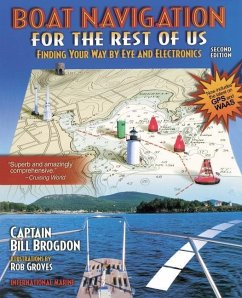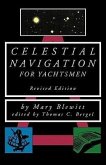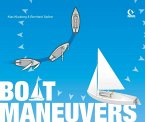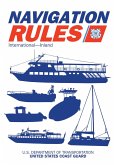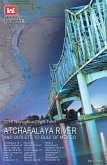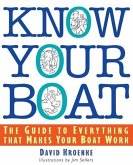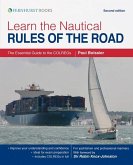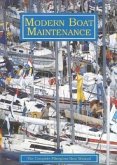Bill Brogdon
Boat Navigation for the Rest of Us: Finding Your Way by Eye and Electronics
Bill Brogdon
Boat Navigation for the Rest of Us: Finding Your Way by Eye and Electronics
- Broschiertes Buch
- Merkliste
- Auf die Merkliste
- Bewerten Bewerten
- Teilen
- Produkt teilen
- Produkterinnerung
- Produkterinnerung
"Superb and amazingly comprehensive."--Cruising World "Thorough treatment of traditional and electronic methods by an expert."-- WoodenBoat Boat Navigation for the Rest of Us is the only book that teaches navigation the way small-boat skippers actually navigate: by combining electronic aids like GPS and radar with commonsense visual piloting skills and simple chartwork. This second edition covers important developments in electronic navigation, including dramatic improvements in GPS accuracy, the growing popularity of electronic charts and plotting systems, and the increasing availability of…mehr
Andere Kunden interessierten sich auch für
![Celestial Navigation for Yachtsmen Celestial Navigation for Yachtsmen]() Mary BlewittCelestial Navigation for Yachtsmen14,99 €
Mary BlewittCelestial Navigation for Yachtsmen14,99 €![Boat Maneuvers Boat Maneuvers]() Klas KlaubergBoat Maneuvers16,99 €
Klas KlaubergBoat Maneuvers16,99 €![Navigation Rules and Regulations Handbook Navigation Rules and Regulations Handbook]() U S Coast GuardNavigation Rules and Regulations Handbook9,49 €
U S Coast GuardNavigation Rules and Regulations Handbook9,49 €![2016 Atchafalaya River Navigation and Flood Control Book: Atchafalaya River and Outlets to Gulf of Mexico 2016 Atchafalaya River Navigation and Flood Control Book: Atchafalaya River and Outlets to Gulf of Mexico]() New Orleans District (U S)2016 Atchafalaya River Navigation and Flood Control Book: Atchafalaya River and Outlets to Gulf of Mexico55,99 €
New Orleans District (U S)2016 Atchafalaya River Navigation and Flood Control Book: Atchafalaya River and Outlets to Gulf of Mexico55,99 €![Know Your Boat Know Your Boat]() David KroenkeKnow Your Boat20,99 €
David KroenkeKnow Your Boat20,99 €![Learn the Nautical Rules of the Road Learn the Nautical Rules of the Road]() Paul BoissierLearn the Nautical Rules of the Road24,99 €
Paul BoissierLearn the Nautical Rules of the Road24,99 €![Modern Boat Maintenance: The Complete Fiberglass Boat Manual Modern Boat Maintenance: The Complete Fiberglass Boat Manual]() Bo StreiffertModern Boat Maintenance: The Complete Fiberglass Boat Manual21,99 €
Bo StreiffertModern Boat Maintenance: The Complete Fiberglass Boat Manual21,99 €-
-
-
"Superb and amazingly comprehensive."--Cruising World "Thorough treatment of traditional and electronic methods by an expert."-- WoodenBoat Boat Navigation for the Rest of Us is the only book that teaches navigation the way small-boat skippers actually navigate: by combining electronic aids like GPS and radar with commonsense visual piloting skills and simple chartwork. This second edition covers important developments in electronic navigation, including dramatic improvements in GPS accuracy, the growing popularity of electronic charts and plotting systems, and the increasing availability of navigation information over the Internet. It's a full course in navigation plus a whole toolbox of little-known tips and shortcuts to deal with real-life situations without a slide rule.
Produktdetails
- Produktdetails
- Verlag: McGraw Hill LLC
- 2nd Revised edition
- Seitenzahl: 232
- Erscheinungstermin: 20. Februar 2001
- Englisch
- Abmessung: 233mm x 186mm x 13mm
- Gewicht: 408g
- ISBN-13: 9780071372268
- ISBN-10: 0071372261
- Artikelnr.: 21971139
- Herstellerkennzeichnung
- Libri GmbH
- Europaallee 1
- 36244 Bad Hersfeld
- gpsr@libri.de
- Verlag: McGraw Hill LLC
- 2nd Revised edition
- Seitenzahl: 232
- Erscheinungstermin: 20. Februar 2001
- Englisch
- Abmessung: 233mm x 186mm x 13mm
- Gewicht: 408g
- ISBN-13: 9780071372268
- ISBN-10: 0071372261
- Artikelnr.: 21971139
- Herstellerkennzeichnung
- Libri GmbH
- Europaallee 1
- 36244 Bad Hersfeld
- gpsr@libri.de
Captain Bill Brogdon (Cape Carteret, NC) served in the U.S. Coast Guard for more than 30 years. He writes regularly for major boating magazines and has twice received the Lawton Award for the most significant contribution to boating safety through the media.
List of Sidebars
Acknowledgments
Introduction
1. How We Navigate
Going to an Object in Sight
Course, Speed, and Time: The DR
Finding the Boat's Position
Electronic Aid-to-Navigation Systems
Blending Visual, Instrument, and Electronic Information
2. Charts and Publications
Charts
Latitude and Longitude; Chart Scale and Projection; Chart Symbols;
Direction and Distance; Depths; Chart Dates and Corrections; Great Lakes
Charts; Charts for Rivers and Reservoirs
Publications
3. Navigation Instruments and Equipment
The Compass
Direction; Variation and Deviation; Bad Compass, Good Course
Depthfinders
Types of Depthfinders; Depth Corrections; Choosing a Depthfinder
Speed and Distance Logs
Time
Binoculars
A Navigator's Kit
Radar
Radar Measurements: Range and Bearing
4. Aid-to-Navigation Systems
Visual Aids to Navigation
Color, Shape, Lights, and Numbers; Intracoastal Waterway Aids to Navigation
Sound Signals
The Global Positioning System and Loran-C
Plotters; Additional Similarities and Differences; Accuracy; Coverage;
Choosing an Electronic Navigation System; Choosing a Receiver; Differential
GPS and WAAS
Radiobeacons and Radio Direction Finders
Racons
Other Radionavigation Systems
5. Finding Where You Are
Seaman's Eye
Radar and Seaman's Eye
Taking Departure
Ded (Dead) Reckoning
Time, Speed, and Distance Calculations
Time; Speed; Distance; Doing the Calculations Mentally; Direction and Time
Lines of Position and Fixes
Objects for Lines of Position; Fixes from Lines of Position; Radar Lines of
Position; Line-of-Position and Fix Errors; Ranges
Estimated Positions
Distance Off
Electronic Navigation Systems
Waypoints
Measuring and Storing Waypoints with a Receiver; Plotting GPS and Loran-C
Positions on a Chart; Position with Respect to Waypoints; Using Waypoints
Measured by Another Receiver; Converting Waypoints from Loran-C to GPS;
Corrections to Waypoint Positions
Avoiding GPS and Loran-C Errors
Check before Getting Underway; Electronic Position Jumps; Out of Tolerance
Signals
6. Finding Where to Go
Seaman's Eye
Frozen Ranges; Steering Clear; Water Colors; Waves
Going to Distant Destinations
Electronic Navigation Systems
Coping with Current
Plotting; Calculating the Lead Angle; Shortcut Lead Angles; Practical
Methods
Following the Desired Track Using a Navigation Receiver
Bearing to Waypoint; Cross-Track Error; Course Made Good; Estimated Time En
Route; Scratch Waypoints; Staying in Good Water
Losing Electronic Navigation
Radar
Blending Electronic and Visual Navigation
Island Chains, Marshes, and Reservoirs
River Navigation
Night Navigation
Navigation in Fog
Radar for Collision Avoidance
Collision Avoidance in Poor Visibility
7. Special Techniques
Riding a Line of Position
The Deliberate Miss
The Electronic Navigation Hook
Look Behind You
Things That Go Wrong
Signs of Trouble; Data Entry Errors; Different Bearings to a Waypoint;
Shifting Waypoints; Which One Is Wrong?; Onboard Interference; External
Interference; Moving the Receiver Long Distances; Cross-Track Error Jumps
to Zero
Appendix A. How GPS Works
Appendix B. How Loran-C Works
Appendix C. Good, Bad, and Ugly Receiver Features
Glossary
Index
Acknowledgments
Introduction
1. How We Navigate
Going to an Object in Sight
Course, Speed, and Time: The DR
Finding the Boat's Position
Electronic Aid-to-Navigation Systems
Blending Visual, Instrument, and Electronic Information
2. Charts and Publications
Charts
Latitude and Longitude; Chart Scale and Projection; Chart Symbols;
Direction and Distance; Depths; Chart Dates and Corrections; Great Lakes
Charts; Charts for Rivers and Reservoirs
Publications
3. Navigation Instruments and Equipment
The Compass
Direction; Variation and Deviation; Bad Compass, Good Course
Depthfinders
Types of Depthfinders; Depth Corrections; Choosing a Depthfinder
Speed and Distance Logs
Time
Binoculars
A Navigator's Kit
Radar
Radar Measurements: Range and Bearing
4. Aid-to-Navigation Systems
Visual Aids to Navigation
Color, Shape, Lights, and Numbers; Intracoastal Waterway Aids to Navigation
Sound Signals
The Global Positioning System and Loran-C
Plotters; Additional Similarities and Differences; Accuracy; Coverage;
Choosing an Electronic Navigation System; Choosing a Receiver; Differential
GPS and WAAS
Radiobeacons and Radio Direction Finders
Racons
Other Radionavigation Systems
5. Finding Where You Are
Seaman's Eye
Radar and Seaman's Eye
Taking Departure
Ded (Dead) Reckoning
Time, Speed, and Distance Calculations
Time; Speed; Distance; Doing the Calculations Mentally; Direction and Time
Lines of Position and Fixes
Objects for Lines of Position; Fixes from Lines of Position; Radar Lines of
Position; Line-of-Position and Fix Errors; Ranges
Estimated Positions
Distance Off
Electronic Navigation Systems
Waypoints
Measuring and Storing Waypoints with a Receiver; Plotting GPS and Loran-C
Positions on a Chart; Position with Respect to Waypoints; Using Waypoints
Measured by Another Receiver; Converting Waypoints from Loran-C to GPS;
Corrections to Waypoint Positions
Avoiding GPS and Loran-C Errors
Check before Getting Underway; Electronic Position Jumps; Out of Tolerance
Signals
6. Finding Where to Go
Seaman's Eye
Frozen Ranges; Steering Clear; Water Colors; Waves
Going to Distant Destinations
Electronic Navigation Systems
Coping with Current
Plotting; Calculating the Lead Angle; Shortcut Lead Angles; Practical
Methods
Following the Desired Track Using a Navigation Receiver
Bearing to Waypoint; Cross-Track Error; Course Made Good; Estimated Time En
Route; Scratch Waypoints; Staying in Good Water
Losing Electronic Navigation
Radar
Blending Electronic and Visual Navigation
Island Chains, Marshes, and Reservoirs
River Navigation
Night Navigation
Navigation in Fog
Radar for Collision Avoidance
Collision Avoidance in Poor Visibility
7. Special Techniques
Riding a Line of Position
The Deliberate Miss
The Electronic Navigation Hook
Look Behind You
Things That Go Wrong
Signs of Trouble; Data Entry Errors; Different Bearings to a Waypoint;
Shifting Waypoints; Which One Is Wrong?; Onboard Interference; External
Interference; Moving the Receiver Long Distances; Cross-Track Error Jumps
to Zero
Appendix A. How GPS Works
Appendix B. How Loran-C Works
Appendix C. Good, Bad, and Ugly Receiver Features
Glossary
Index
List of Sidebars
Acknowledgments
Introduction
1. How We Navigate
Going to an Object in Sight
Course, Speed, and Time: The DR
Finding the Boat's Position
Electronic Aid-to-Navigation Systems
Blending Visual, Instrument, and Electronic Information
2. Charts and Publications
Charts
Latitude and Longitude; Chart Scale and Projection; Chart Symbols;
Direction and Distance; Depths; Chart Dates and Corrections; Great Lakes
Charts; Charts for Rivers and Reservoirs
Publications
3. Navigation Instruments and Equipment
The Compass
Direction; Variation and Deviation; Bad Compass, Good Course
Depthfinders
Types of Depthfinders; Depth Corrections; Choosing a Depthfinder
Speed and Distance Logs
Time
Binoculars
A Navigator's Kit
Radar
Radar Measurements: Range and Bearing
4. Aid-to-Navigation Systems
Visual Aids to Navigation
Color, Shape, Lights, and Numbers; Intracoastal Waterway Aids to Navigation
Sound Signals
The Global Positioning System and Loran-C
Plotters; Additional Similarities and Differences; Accuracy; Coverage;
Choosing an Electronic Navigation System; Choosing a Receiver; Differential
GPS and WAAS
Radiobeacons and Radio Direction Finders
Racons
Other Radionavigation Systems
5. Finding Where You Are
Seaman's Eye
Radar and Seaman's Eye
Taking Departure
Ded (Dead) Reckoning
Time, Speed, and Distance Calculations
Time; Speed; Distance; Doing the Calculations Mentally; Direction and Time
Lines of Position and Fixes
Objects for Lines of Position; Fixes from Lines of Position; Radar Lines of
Position; Line-of-Position and Fix Errors; Ranges
Estimated Positions
Distance Off
Electronic Navigation Systems
Waypoints
Measuring and Storing Waypoints with a Receiver; Plotting GPS and Loran-C
Positions on a Chart; Position with Respect to Waypoints; Using Waypoints
Measured by Another Receiver; Converting Waypoints from Loran-C to GPS;
Corrections to Waypoint Positions
Avoiding GPS and Loran-C Errors
Check before Getting Underway; Electronic Position Jumps; Out of Tolerance
Signals
6. Finding Where to Go
Seaman's Eye
Frozen Ranges; Steering Clear; Water Colors; Waves
Going to Distant Destinations
Electronic Navigation Systems
Coping with Current
Plotting; Calculating the Lead Angle; Shortcut Lead Angles; Practical
Methods
Following the Desired Track Using a Navigation Receiver
Bearing to Waypoint; Cross-Track Error; Course Made Good; Estimated Time En
Route; Scratch Waypoints; Staying in Good Water
Losing Electronic Navigation
Radar
Blending Electronic and Visual Navigation
Island Chains, Marshes, and Reservoirs
River Navigation
Night Navigation
Navigation in Fog
Radar for Collision Avoidance
Collision Avoidance in Poor Visibility
7. Special Techniques
Riding a Line of Position
The Deliberate Miss
The Electronic Navigation Hook
Look Behind You
Things That Go Wrong
Signs of Trouble; Data Entry Errors; Different Bearings to a Waypoint;
Shifting Waypoints; Which One Is Wrong?; Onboard Interference; External
Interference; Moving the Receiver Long Distances; Cross-Track Error Jumps
to Zero
Appendix A. How GPS Works
Appendix B. How Loran-C Works
Appendix C. Good, Bad, and Ugly Receiver Features
Glossary
Index
Acknowledgments
Introduction
1. How We Navigate
Going to an Object in Sight
Course, Speed, and Time: The DR
Finding the Boat's Position
Electronic Aid-to-Navigation Systems
Blending Visual, Instrument, and Electronic Information
2. Charts and Publications
Charts
Latitude and Longitude; Chart Scale and Projection; Chart Symbols;
Direction and Distance; Depths; Chart Dates and Corrections; Great Lakes
Charts; Charts for Rivers and Reservoirs
Publications
3. Navigation Instruments and Equipment
The Compass
Direction; Variation and Deviation; Bad Compass, Good Course
Depthfinders
Types of Depthfinders; Depth Corrections; Choosing a Depthfinder
Speed and Distance Logs
Time
Binoculars
A Navigator's Kit
Radar
Radar Measurements: Range and Bearing
4. Aid-to-Navigation Systems
Visual Aids to Navigation
Color, Shape, Lights, and Numbers; Intracoastal Waterway Aids to Navigation
Sound Signals
The Global Positioning System and Loran-C
Plotters; Additional Similarities and Differences; Accuracy; Coverage;
Choosing an Electronic Navigation System; Choosing a Receiver; Differential
GPS and WAAS
Radiobeacons and Radio Direction Finders
Racons
Other Radionavigation Systems
5. Finding Where You Are
Seaman's Eye
Radar and Seaman's Eye
Taking Departure
Ded (Dead) Reckoning
Time, Speed, and Distance Calculations
Time; Speed; Distance; Doing the Calculations Mentally; Direction and Time
Lines of Position and Fixes
Objects for Lines of Position; Fixes from Lines of Position; Radar Lines of
Position; Line-of-Position and Fix Errors; Ranges
Estimated Positions
Distance Off
Electronic Navigation Systems
Waypoints
Measuring and Storing Waypoints with a Receiver; Plotting GPS and Loran-C
Positions on a Chart; Position with Respect to Waypoints; Using Waypoints
Measured by Another Receiver; Converting Waypoints from Loran-C to GPS;
Corrections to Waypoint Positions
Avoiding GPS and Loran-C Errors
Check before Getting Underway; Electronic Position Jumps; Out of Tolerance
Signals
6. Finding Where to Go
Seaman's Eye
Frozen Ranges; Steering Clear; Water Colors; Waves
Going to Distant Destinations
Electronic Navigation Systems
Coping with Current
Plotting; Calculating the Lead Angle; Shortcut Lead Angles; Practical
Methods
Following the Desired Track Using a Navigation Receiver
Bearing to Waypoint; Cross-Track Error; Course Made Good; Estimated Time En
Route; Scratch Waypoints; Staying in Good Water
Losing Electronic Navigation
Radar
Blending Electronic and Visual Navigation
Island Chains, Marshes, and Reservoirs
River Navigation
Night Navigation
Navigation in Fog
Radar for Collision Avoidance
Collision Avoidance in Poor Visibility
7. Special Techniques
Riding a Line of Position
The Deliberate Miss
The Electronic Navigation Hook
Look Behind You
Things That Go Wrong
Signs of Trouble; Data Entry Errors; Different Bearings to a Waypoint;
Shifting Waypoints; Which One Is Wrong?; Onboard Interference; External
Interference; Moving the Receiver Long Distances; Cross-Track Error Jumps
to Zero
Appendix A. How GPS Works
Appendix B. How Loran-C Works
Appendix C. Good, Bad, and Ugly Receiver Features
Glossary
Index

